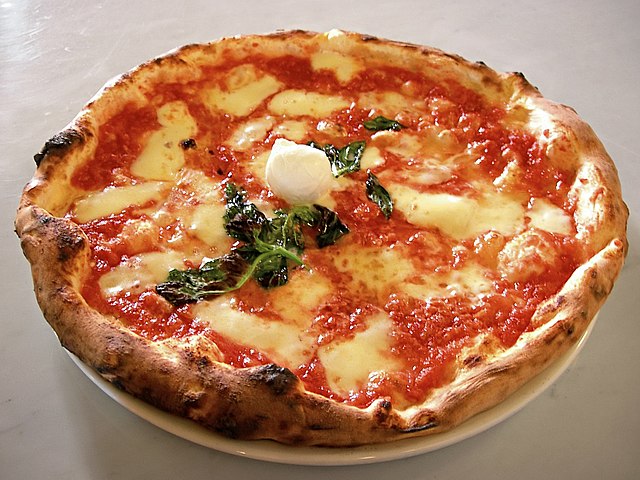pizza
From Wiktionary, the free dictionary
See also: Pizza and pizzą
English
Alternative forms
Etymology
1931, borrowed from Neapolitan pizza (1590), the Neapolitan dialectal form of Byzantine Greek πίτα (píta, “cake, pie”). The Greek word is first attested in 1107 and is itself of uncertain origin. The northern Italian dialectal form was pinza, the southern (Apulian and Calabrian) form was pitta. This suggests a derivation from Latin pīnctus (pictus (“painted, smeared”)) or pīnsum, pīnsitum, pistum (“pounded”), but the northern forms appear to be contaminated with pinzare (“to staple”). There are alternative suggestions involving Greek etymologies (πηκτή (pēktḗ), πηκτός (pēktós, “compacted, congealed”); πήτεα (pḗtea, “bran”); Ancient Greek πιττάκιον (pittákion, “patch; tablet; ticket”)), more remote possibilities involve comparison with Lombardic pizzo, pizza (“bite, morsel, lump, dumpling”); Albanian petë (“layer”), Romanian pată (“blotch, stain, macula”); Albanian pite (“gruel”); From Aramaic פִיתָּא (pītā, “piece of bread”), Hebrew פַּת (paṯ, “bread”). Doublet of pide and pita.
Pronunciation
Noun
pizza (countable and uncountable, plural pizzas or (rare) pizze)
- (uncountable) A baked Italian dish of a thinly rolled bread crust typically topped before baking with tomato sauce, cheese, and other ingredients such as meat or vegetables.
- Synonym: 'za
- a slice of pizza
- a pizza pie
- Want to go out for pizza tonight?
- (countable) A single instance of this dish.
Derived terms
- California pizza
- California-style pizza
- cheese pizza
- Chicago pizza
- Chicago-style pizza
- Chicago style pizza
- deep dish pizza
- deepdish pizza
- deep-dish pizza
- garden pizza
- German pizza
- Greek pizza
- Hawaiian pizza
- Japanese pizza
- licorice pizza
- Margherita pizza
- margherita pizza
- New York pizza
- New York-style pizza
- New York style pizza
- nonpizza
- pan pizza
- pavement pizza
- pavement-pizza
- pierogi pizza
- pizza bagel
- pizza bite
- pizza bone
- pizza box
- pizza boy
- pizza casserole
- pizza crunch
- pizza cutter
- pizzadilla
- pizza dish
- pizza face
- pizza-face
- pizza farm
- pizza fractions
- pizza fritta
- Pizzagate
- pizza-ghetti
- pizza girl
- pizza guy
- pizza lady
- pizzamaker
- pizza man
- pizza Margherita
- Pizza Meter
- pizza naan
- pizza nigger
- pizza oven
- pizza paddle
- pizza pan
- pizza parlor
- pizza parlour
- pizza peel
- pizza pie
- pizza pocket
- pizza popper
- pizza puff
- pizzarito
- pizza roll
- pizza sauce
- pizza saver
- pizza shop
- pizza stone
- pizza store
- pizza sub
- pizza submarine sandwich
- pizza sub sandwich
- pizza table
- pizza toast
- pizza wheel
- pizza woman
- pizzeria
- pizzetta
- poor man's pizza
- road pizza
- sheet pizza
- spaghetti pizza
- sushi pizza
- thick-crust pizza
- thin-crust pizza
- track pizza
- Turkish pizza
- two-pizza rule
- white pizza
Related terms
Translations
baked Italian dish
|
a single instance of that dish
|
Further reading
Catalan
Etymology
Pronunciation
Noun
pizza f (plural pizzes)
Derived terms
Related terms
Chinese
Etymology 1
Pronunciation
- Mandarin
- (Standard Chinese)
- Hanyu Pinyin:
- Zhuyin: ㄅㄧˇ ㄙㄚˋ
- Tongyong Pinyin: bǐsà
- Wade–Giles: pi3-sa4
- Yale: bǐ-sà
- Gwoyeu Romatzyh: biisah
- Palladius: биса (bisa)
- Sinological IPA (key): /pi²¹⁴⁻²¹ sä⁵¹/
- Homophones:
- (Standard Chinese)
Noun
pizza
- (Mainland China, neologism) Alternative form of 比薩 / 比萨 (bǐsà, “pizza”)
- 2005, 子尤, 《谁的青春有我狂》, 少年儿童出版社, →ISBN, page 251:
- 那时我们得空还是会往姥姥家跑,一天,王钊打电话告诉我,准备 9 月 30 日,学校放假的那天请朋友们在 pizza 饼店吃饭。
- (please add an English translation of this quotation)
Etymology 2
Pronunciation
- Cantonese
- (Standard Cantonese, Guangzhou–Hong Kong)+
- Jyutping: pi1 saa4 / pi1 saa2
- Yale: pī sàh / pī sá
- Cantonese Pinyin: pi1 saa4 / pi1 saa2
- Guangdong Romanization: pi1 sa4 / pi1 sa2
- Sinological IPA (key): /pʰiː⁵⁵ saː²¹/, /pʰiː⁵⁵ saː³⁵/
- (Standard Cantonese, Guangzhou–Hong Kong)+
Noun
pizza
Alternative forms
- 披莎, 批莎
Synonyms
Czech
Etymology
Pronunciation
Noun
pizza f
Declension
Declension of pizza (hard feminine)
Related terms
- pizzerie f
Danish
Etymology
Pronunciation
Noun
pizza c (singular definite pizzaen, plural indefinite pizzaer)
- pizza [from 1957]
Inflection
| common gender |
singular | plural | ||
|---|---|---|---|---|
| indefinite | definite | indefinite | definite | |
| nominative | pizza | pizzaen | pizzaer | pizzaerne |
| genitive | pizzas | pizzaens | pizzaers | pizzaernes |
Dutch
Etymology
Pronunciation
Noun
pizza f (plural pizza's, diminutive pizzaatje n)
Derived terms
- pizzabodem
- pizzadoos
- pizzaoven
- pizzarestaurant
- pizzatent
- straatpizza
- Turkse pizza
Related terms
Finnish
French
Galician
Hungarian
Icelandic
Interlingua
Italian
Maltese
Neapolitan
Norwegian Bokmål
Norwegian Nynorsk
Old High German
Polish
Portuguese
Romanian
Slovak
Spanish
Swedish
Turkish
Wikiwand - on
Seamless Wikipedia browsing. On steroids.







